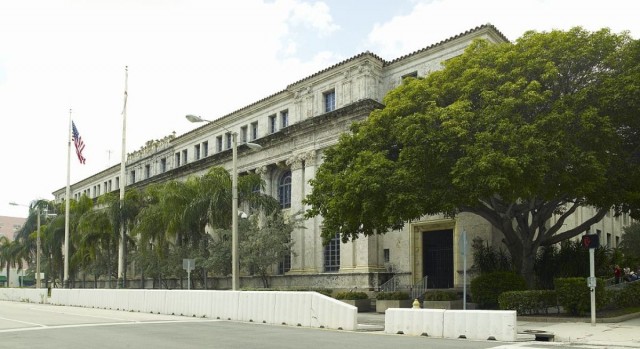
Continuing his examination of underperforming and vacant federal real estate, last Friday (March 8) Rep. John Mica (R-Fla.) held the first field hearing of the House Oversight and Government Reform Committee’s Government Operations Subcommittee at Miami Dade College. As chairman of the newly created committee, Mica used this hearing to highlight ongoing problems of space use and overbuilding of federal courthouses, focusing again on the David W. Dyer Federal Building and U.S. Courthouse.
Titled “Addressing Unused and Vacant Federal Courthouses: A Case Study in Miami-Dade, Florida,” the hearing examined the limited progress than has been made toward a reuse plan for the Dyer Courthouse, which has been vacant since 2008 and was the site of an August 2012 hearing by the House Committee on Transportation and Infrastructure subcommittee that Mica chaired at the time.
GSA Public Buildings Service Regional Commissioner John Smith testified that GSA is “actively exploring repositioning strategies” for the historic courthouse. While GSA’s initial plan was to house other federal agencies there, the cost of doing so was deemed prohibitive, and the agency is now looking at other options. “In August of 2012, we issued a request for information (RFI) seeking ideas for redeveloping and preserving the property,” Smith noted. “We received interest from two sources, neither of which offered a viable option as proposed; however, we are happy to work with Miami Dade College and the other respondent to see if there are ways to make their proposals more workable.”
Specifically, Smith added, the college’s proposal for GSA to give the property to the institution under a public benefit conveyance would require GSA to report the property excess. “In light of that interest,” Smith continued, “we are currently preparing due diligence for a report of excess while assessing other potential strategies for the building.” In his concluding remarks, he stressed that GSA “is exploring all potential repositioning strategies” and is engaging with the public and private sectors to find the strategy with the highest benefit to the taxpayer.
Mark L. Goldstein, director of physical infrastructure issues at the Government Accountability Office (GAO), whose testimony was based largely on GAO’s June 2010 report on federal courthouse construction, noted that between 2000 and 2010, 33 federal courthouses were overbuilt by more than 3.56 million square feet (the size of about nine average-sized courthouses) at an estimated cost of $835 million; the federal government spends $51 million each year to rent, operate, and/or maintain this space. The Wilkie D. Ferguson, Jr. U.S. Courthouse—which was built to replace the Dyer Building—contains approximately 238,000 extra square feet of space, which GAO estimated increased the construction cost by $48.5 million and an additional $3.5 million annually. GAO has recommended that GSA establish controls to help ensure that future courthouses remain within their authorized size, and that the judiciary improve its estimation of future space needs (and limit those needs by expanding courtroom sharing policies); both GSA and the judiciary have agreed to implement these suggestions.
Finally, Eduardo Padron, president of Miami Dade College, testified about the college’s desire to integrate the Dyer Courthouse—located adjacent to the main building of its downtown campus—into that campus. “As you look into streamlining the federal property disposal process, I believe Miami Dade College can serve as a model demonstrating the important contribution the education sector can make to your efforts,” he noted, citing the college’s track record of successfully reusing underutilized properties and restoring historic buildings, including the Freedom Tower (also known as “the Ellis Island of the South,” which was donated to the college in 2005) and a federally owned parking lot conveyed to the institution in 2009 that will soon be redeveloped as a classroom and parking garage building with an enclosed and secure parking area for federal Bureau of Prisons and Department of Justice employees.
“I am aware that efforts to improve government efficiency and generate revenue for the treasury are important elements of an effective federal disposal process. However, focusing on maximizing fair market sales should not be your only option,” said Padron. “In many cases, the costs of bringing a property to market exceed the proceeds from a sale. The option of maximizing a fair market value sale should be weighed against the value of a public benefit conveyance. The end result will be better utilization of these federal properties, to the benefit of our communities and nation.” He noted that the college continues to work with GSA as it awaits the results of that agency’s internal review and screening process.
Throughout the hearing, Mica expressed his frustration with how long the disposition process is taking—and with how much it is costing taxpayers—repeatedly asking “how long is this going to take?” and “how can we expedite this process?” All respondents answered that working through the process takes time, but insisted that progress is being made. Mica concluded by saying “we want a positive outcome, and I hope I don’t have to come again … unless it’s for a conveyance ceremony.”

